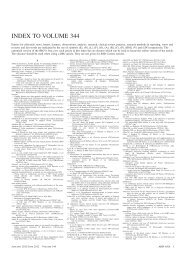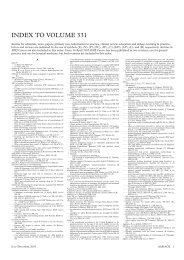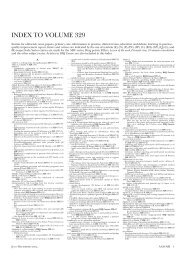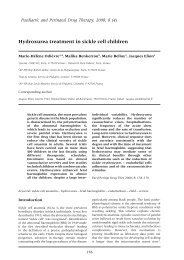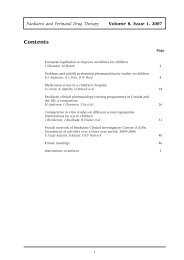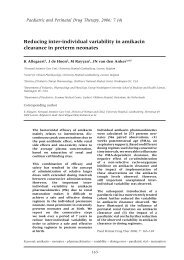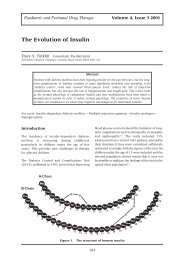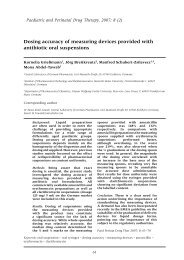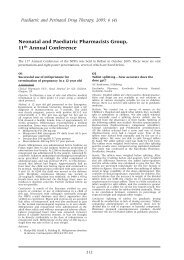Indomethacin Treatment of Patent Ductus Arteriosus in ... - BMJ Group
Indomethacin Treatment of Patent Ductus Arteriosus in ... - BMJ Group
Indomethacin Treatment of Patent Ductus Arteriosus in ... - BMJ Group
Create successful ePaper yourself
Turn your PDF publications into a flip-book with our unique Google optimized e-Paper software.
Paediatric and Per<strong>in</strong>atal Drug Therapy Volume 4, Issue 3 2001<br />
<strong>Indomethac<strong>in</strong></strong> <strong>Treatment</strong> <strong>of</strong> <strong>Patent</strong> <strong>Ductus</strong><br />
<strong>Arteriosus</strong> <strong>in</strong> Premature Infants<br />
John McIntyre Senior Lecturer <strong>in</strong> Child Health<br />
Academic Division <strong>of</strong> Child Health (University <strong>of</strong> Nott<strong>in</strong>gham), Derbyshire Children’s Hospital, Uttoxeter Road, Derby DE22<br />
3NE, UK. email: john.mc<strong>in</strong>tyre@nott<strong>in</strong>gham.ac.uk<br />
Bart Van Overmeire Senior Lecturer <strong>in</strong> Neonatology<br />
Department <strong>of</strong> Paediatrics, University Hospital <strong>of</strong> Antwerp, Wilrijkstreet 10, B-2650 Edegem, Belgium<br />
John N. van den Anker Pr<strong>of</strong>essor <strong>of</strong> Paediatrics and Neonatology<br />
Sophia Children’s Hospital, Rotterdam, The Netherlands<br />
Key words: <strong>Indomethac<strong>in</strong></strong> – <strong>Ductus</strong> arteriosus, patent – Infant, premature<br />
Introduction<br />
In fetal circulation the ductus arteriosus channels<br />
blood from the pulmonary artery directly <strong>in</strong>to the<br />
descend<strong>in</strong>g aorta. This enables about 90% <strong>of</strong> right<br />
ventricular output to bypass the unexpanded<br />
lungs. At birth, functional closure <strong>of</strong> this channel<br />
redirects blood flow to the pulmonary vascular<br />
bed and allows the lungs to start effective<br />
respiratory gas exchange. Closure <strong>in</strong>volves<br />
<strong>in</strong>teraction <strong>of</strong> oxygen, prostagland<strong>in</strong>s, nitric oxide<br />
and the unique musculature <strong>of</strong> the ductus<br />
arteriosus 1–3 . In healthy term babies, ducts are<br />
functionally closed <strong>in</strong> 20% on day 1, 82% by day<br />
2, 96% by day 3 and 100% by day 4 4 .<br />
These mechanisms do not always occur promptly<br />
<strong>in</strong> premature <strong>in</strong>fants. A patent ductus arteriosus<br />
Abstract<br />
Shortly after birth, physiological processes usually effect prompt functional closure <strong>of</strong> the ductus<br />
arteriosus. With <strong>in</strong>creas<strong>in</strong>g prematurity there is an <strong>in</strong>creased likelihood <strong>of</strong> the ductus arteriosus<br />
rema<strong>in</strong><strong>in</strong>g patent. To overcome the undesirable effects <strong>of</strong> left to right shunt<strong>in</strong>g <strong>of</strong> blood through<br />
the patent ductus arteriosus (PDA), closure by surgical ligation and medical treatment have<br />
become established practice. S<strong>in</strong>ce the mid-1970s, <strong>in</strong>domethac<strong>in</strong>, an <strong>in</strong>hibitor <strong>of</strong> prostagland<strong>in</strong><br />
synthesis, has been used to promote closure <strong>of</strong> a PDA. Despite longstand<strong>in</strong>g use and numerous<br />
cl<strong>in</strong>ical trials, the optimal management rema<strong>in</strong>s unclear. This overview covers the pharmacology<br />
<strong>of</strong> <strong>in</strong>domethac<strong>in</strong> <strong>in</strong> the neonate and its use for treat<strong>in</strong>g PDA <strong>in</strong> the premature <strong>in</strong>fant.<br />
85<br />
(PDA) is found <strong>in</strong> about 40% <strong>of</strong> <strong>in</strong>fants <strong>of</strong><br />
< 1000 g birthweight on day 3 5 , and, <strong>in</strong> <strong>in</strong>fants <strong>of</strong><br />
< 28 weeks’ gestation, spontaneous closure by<br />
day 5 occurs <strong>in</strong> only 27% 6 . Left to right shunt<strong>in</strong>g<br />
<strong>of</strong> blood through a haemodynamically significant<br />
PDA <strong>in</strong>creases pulmonary blood flow and cardiac<br />
workload, and reduces renal and gastro<strong>in</strong>test<strong>in</strong>al<br />
blood flow. A PDA has been thought to <strong>in</strong>crease<br />
the severity <strong>of</strong> respiratory distress 7,8 and the risk<br />
<strong>of</strong> bronchopulmonary dysplasia 9 .<br />
Surgical ligation and medical drugs, most<br />
commonly <strong>in</strong>domethac<strong>in</strong>, are used to treat<br />
<strong>in</strong>fants with a haemodynamically significant<br />
PDA. Pharmacological closure <strong>of</strong> a PDA <strong>in</strong><br />
premature <strong>in</strong>fants was first reported <strong>in</strong> 1976 10,11<br />
and subsequent studies show it to be effective <strong>in</strong><br />
about 80% <strong>of</strong> treated <strong>in</strong>fants 12 . <strong>Indomethac<strong>in</strong></strong> has
Paediatric and Per<strong>in</strong>atal Drug Therapy, 2001; 4 (3)<br />
also been used to prevent a symptomatic PDA<br />
develop<strong>in</strong>g <strong>in</strong> at-risk <strong>in</strong>fants 13 . However, despite<br />
over 30 years <strong>of</strong> various approaches, the<br />
optimum regimen for the management <strong>of</strong> PDA <strong>in</strong><br />
prematurity has still not been unequivocally<br />
established.<br />
Pharmacology <strong>of</strong> <strong>Indomethac<strong>in</strong></strong><br />
<strong>Indomethac<strong>in</strong></strong> is a methylated <strong>in</strong>dole derivative<br />
and a non-selective potent <strong>in</strong>hibitor <strong>of</strong> the<br />
prostagland<strong>in</strong>-form<strong>in</strong>g cyclo-oxygenase. It is<br />
highly bound to serum prote<strong>in</strong>s. Metabolism via<br />
O-methylation, deacylation and conjugation to<br />
<strong>in</strong>active metabolites allows for elim<strong>in</strong>ation via the<br />
biliary route; < 10% is excreted unchanged <strong>in</strong> the<br />
ur<strong>in</strong>e 3 .<br />
Intravenous <strong>in</strong>domethac<strong>in</strong> <strong>in</strong> adults has a plasma<br />
half-life <strong>of</strong> 2.6–11.2 h and a plasma clearance <strong>of</strong><br />
44–109 ml/kg/h 14,15 . Def<strong>in</strong><strong>in</strong>g pharmacok<strong>in</strong>etic<br />
parameters <strong>in</strong> the neonate is hampered by the<br />
many physiological changes occurr<strong>in</strong>g after birth.<br />
Despite their limitations, pharmacok<strong>in</strong>etic studies<br />
that have been attempted do give some <strong>in</strong>sight.<br />
With oral adm<strong>in</strong>istration, absorption <strong>of</strong><br />
<strong>in</strong>domethac<strong>in</strong> is <strong>in</strong>complete and variable 16 . For<br />
<strong>in</strong>travenous <strong>in</strong>domethac<strong>in</strong>, studies have used<br />
different doses (0.2, 0.25 and 0.3 mg/kg) but all<br />
show large <strong>in</strong>ter-<strong>in</strong>dividual variations and<br />
important differences compared with the adult<br />
data: plasma half-life (t 1/2 : 11–36 h) is much<br />
longer and the clearance rate (7–16 ml/kg/h)<br />
much less 17–20 . There are also large <strong>in</strong>ter<strong>in</strong>dividual<br />
variations <strong>in</strong> the apparent volume <strong>of</strong><br />
distribution, and the duct be<strong>in</strong>g open or closed<br />
may <strong>in</strong> part contribute to this 19 . Increas<strong>in</strong>g<br />
postnatal age, not gestational age, is an important<br />
determ<strong>in</strong>ant <strong>of</strong> <strong>in</strong>creas<strong>in</strong>g <strong>in</strong>domethac<strong>in</strong><br />
clearance and volume <strong>of</strong> distribution. A study <strong>of</strong><br />
the population pharmacok<strong>in</strong>etic parameters <strong>of</strong><br />
<strong>in</strong>domethac<strong>in</strong> found similar results 21 .<br />
The relationship between the plasma concentration<br />
<strong>of</strong> <strong>in</strong>domethac<strong>in</strong> and the desired effect <strong>of</strong><br />
ductal closure is controversial. In some studies<br />
plasma concentration has not correlated with<br />
efficacy 12,22,23 . In contrast, others have found a<br />
relationship 19,21,24–28 . Various effective concentrations<br />
are suggested: 1 mg/l 10 h post-dose 24 ;<br />
0.5 mg/l 8 h post-dose 25 ; and 0.25 mg/l over a<br />
three-day course 27 . From population pharmacok<strong>in</strong>etic<br />
data, the mean serum concentration at<br />
PDA closure was 1.43 mg/l 21 . Furthermore, low<br />
plasma levels <strong>of</strong> <strong>in</strong>domethac<strong>in</strong>, short t 1/2 and more<br />
efficient clearance, are associated with unsuccessful<br />
<strong>in</strong>domethac<strong>in</strong> <strong>in</strong>fusions 19 .<br />
86<br />
Surgical <strong>Treatment</strong><br />
From the early 1970s surgical ligation has been<br />
used <strong>in</strong> premature neonates with a PDA, but,<br />
with <strong>in</strong>creas<strong>in</strong>g use <strong>of</strong> <strong>in</strong>domethac<strong>in</strong> surgery, is<br />
more <strong>of</strong>ten reserved for <strong>in</strong>fants with<br />
contra<strong>in</strong>dications to, or failure <strong>of</strong>, medical<br />
treatment. The National Collaborative Study<br />
suggested surgery as a backup treatment 12 .<br />
However, some reports recommend surgery as<br />
the first-l<strong>in</strong>e approach <strong>in</strong> extremely low-birthweight<br />
<strong>in</strong>fants. The perioperative complications<br />
associated with surgery <strong>in</strong>clude hypertension,<br />
pneumothorax, chylothorax, ductal tear, m<strong>in</strong>or<br />
wound <strong>in</strong>fections and vocal cord paralysis.<br />
Morbidity rates reported are 1–16% and<br />
mortality 0–10% 29–32 . In experienced centres with<br />
low morbidity and mortality, surgery may be an<br />
appropriate alternative <strong>in</strong> extremely low-birthweight<br />
<strong>in</strong>fants where <strong>in</strong>domethac<strong>in</strong> has a high<br />
failure rate and significant adverse effects.<br />
Medical <strong>Treatment</strong><br />
Tim<strong>in</strong>g <strong>of</strong> <strong>Treatment</strong><br />
With respect to tim<strong>in</strong>g, medical treatment may be<br />
prophylactic (usually with<strong>in</strong> 24 hours <strong>of</strong> birth),<br />
early (2–3 days) or late (8–10 days). Clyman 33<br />
identified four general treatment strategies that<br />
have been studied with respect to tim<strong>in</strong>g:<br />
Late symptomatic vs. no backup.<br />
Late symptomatic vs. later backup.<br />
Early symptomatic vs. late symptomatic.<br />
Prophylactic vs. early symptomatic.<br />
The only study <strong>of</strong> Strategy 1 was too small to<br />
draw firm conclusions, but ductal closure did<br />
appear associated with reduced mechanical<br />
ventilation, necrotis<strong>in</strong>g enterocolitis (NEC) and<br />
ret<strong>in</strong>opathy <strong>of</strong> prematurity (ROP) 34 . In the other<br />
studies, a backup treatment (<strong>in</strong>domethac<strong>in</strong> or<br />
ligation) was available. From meta-analysis <strong>of</strong> the<br />
studies available <strong>in</strong> 1996 33 , the group receiv<strong>in</strong>g<br />
early symptomatic treatment with <strong>in</strong>domethac<strong>in</strong><br />
had a reduction <strong>in</strong> bronchopulmonary dysplasia<br />
(OR = 0.39, CI 0.21–0.76; p < 0.005), need for<br />
mechanical ventilation (p < 0.005) and NEC<br />
(OR = 0.24; CI = 0.06–0.96; p < 0.05) compared<br />
with late symptomatic treatment. Prophylactic<br />
treatment did not have any advantage <strong>in</strong> longterm<br />
pulmonary outcomes or NEC compared<br />
with early symptomatic treatment; however, the<br />
<strong>in</strong>cidence <strong>of</strong> grade 3 and 4 <strong>in</strong>traventricular<br />
haemorrhage (IVH) was reduced (OR = 0.51; CI =<br />
0.28–0.95; p < 0.05). In another systematic review<br />
and meta-analysis, Fowlie 35 found evidence that<br />
prophylactic <strong>in</strong>domethac<strong>in</strong> reduced the <strong>in</strong>cidence<br />
<strong>of</strong> symptomatic PDA (estimate <strong>of</strong> risk difference<br />
–0.217; CI –0.275, –0.160) and the <strong>in</strong>cidence <strong>of</strong><br />
grades 3 and 4 IVH (estimate <strong>of</strong> risk difference
–0.039; CI –0.066, –0.011). However, mortality<br />
and other morbidity was not significantly affected.<br />
The benefit <strong>of</strong> prophylactic <strong>in</strong>domethac<strong>in</strong> <strong>in</strong><br />
reduc<strong>in</strong>g the <strong>in</strong>cidence <strong>of</strong> IVH may be <strong>in</strong>dependent<br />
<strong>of</strong> its effect on a PDA. There is evidence <strong>of</strong> lowdose<br />
prophylactic <strong>in</strong>domethac<strong>in</strong> reduc<strong>in</strong>g IVH 36 .<br />
More recently it has been suggested that<br />
prophylaxis may also reduce the <strong>in</strong>cidence <strong>of</strong><br />
periventricular leukomalacia (PVL) 6 .<br />
Length <strong>of</strong> <strong>Treatment</strong><br />
A commonly used course <strong>of</strong> <strong>in</strong>domethac<strong>in</strong> is three<br />
doses. The National Collaborative Study used three<br />
doses at 12-hourly <strong>in</strong>tervals: 0.2 mg/kg for <strong>in</strong>fants<br />
<strong>in</strong> the first 2–7 days and 0.2 mg/kg followed by<br />
0.25 mg/kg for the second and third dose for<br />
<strong>in</strong>fants > 8 days. The <strong>in</strong>itial response rate <strong>of</strong> duct<br />
closure (about 80%) and subsequent reopen<strong>in</strong>g <strong>in</strong><br />
responders (about 30%) was broadly <strong>in</strong> keep<strong>in</strong>g<br />
with the many previous studies 12 . To improve<br />
susta<strong>in</strong>ed closure rates, prolonged courses <strong>of</strong><br />
<strong>in</strong>domethac<strong>in</strong> have been suggested as an<br />
alternative 24,37,38 .<br />
Us<strong>in</strong>g <strong>in</strong>domethac<strong>in</strong> level monitor<strong>in</strong>g to<br />
<strong>in</strong>dividually tailor doses it was suggested that<br />
ma<strong>in</strong>ta<strong>in</strong><strong>in</strong>g a plasma level <strong>of</strong> 0.5 mg/l for a week<br />
would be effective <strong>in</strong> ma<strong>in</strong>ta<strong>in</strong><strong>in</strong>g duct closure 24 . In<br />
a study <strong>of</strong> 39 low-birth-weight babies with a PDA,<br />
after three doses <strong>of</strong> <strong>in</strong>domethac<strong>in</strong> at 0.2 mg/kg,<br />
babies were randomised to placebo or<br />
0.2 mg/kg/day for five days 37 . The ma<strong>in</strong>tenance<br />
regimen reduced the PDA recurrence rate and the<br />
need for surgical ligation. In a study <strong>of</strong> 121 babies,<br />
where PDA detection and follow-up was cl<strong>in</strong>ical,<br />
0.1 mg/kg/day for six days was compared with<br />
three doses <strong>of</strong> 0.2 mg/kg 12-hourly 38 . For the<br />
prolonged course, the <strong>in</strong>itial response rate was<br />
better (90% vs. 77%) and <strong>of</strong> the responders the<br />
relapse rate (21% vs. 40%) was lower.<br />
Other studies have not confirmed the advantages<br />
<strong>of</strong> a prolonged course. In a study <strong>of</strong> 70 low-birthweight<br />
<strong>in</strong>fants, randomisation was to just two<br />
doses <strong>of</strong> 0.15 mg/kg 12 hours apart or a<br />
ma<strong>in</strong>tenance regimen <strong>of</strong> 0.1 mg/kg/day for five<br />
days after the <strong>in</strong>itial doses 39 . The <strong>in</strong>itial closure rate<br />
appeared better <strong>in</strong> the ma<strong>in</strong>tenance group but<br />
overall the <strong>in</strong>cidence <strong>of</strong> reopen<strong>in</strong>g was not<br />
different. More recently short versus prolonged<br />
<strong>in</strong>domethac<strong>in</strong> therapy was compared <strong>in</strong> 61<br />
preterm <strong>in</strong>fants with a PDA, confirmed on<br />
echocardiography 40 . Those receiv<strong>in</strong>g a short course<br />
had a shorter duration <strong>of</strong> oxygen supplementation<br />
and less frequent symptoms <strong>of</strong> NEC, but susta<strong>in</strong>ed<br />
closure rates (74% vs. 60%), mortality and other<br />
neonatal morbidity rates were similar. It was<br />
concluded that a prolonged course <strong>of</strong>fered no<br />
advantages over a standard course <strong>in</strong> preterm<br />
87<br />
Paediatric and Per<strong>in</strong>atal Drug Therapy, 2001; 4 (3)<br />
Table 1. <strong>Indomethac<strong>in</strong></strong> for closure <strong>of</strong><br />
PDA-licensed recommendations (from<br />
ABP1 Compendium <strong>of</strong> Data Sheets and<br />
Summaries <strong>of</strong> Product Characteristics<br />
1999–2000)<br />
Age at<br />
first dose<br />
Intravenous dose<br />
(microgram/kg)<br />
1st dose 2nd dose 3rd dose<br />
< 48 hours 200 100 100<br />
2–7 days 200 200 200<br />
> 7days 200 250 250<br />
<strong>in</strong>fants with a haemodynamically significant PDA.<br />
In the absence <strong>of</strong> a clear benefit for prolonged<br />
courses, the current licensed therapy (shown <strong>in</strong><br />
Table 1) is three <strong>in</strong>travenous doses given at<br />
12–24-hour <strong>in</strong>tervals.<br />
Other Effects <strong>of</strong> <strong>Indomethac<strong>in</strong></strong><br />
As a non-specific prostagland<strong>in</strong> synthesis<br />
<strong>in</strong>hibitor, <strong>in</strong>domethac<strong>in</strong> would be expected to<br />
have a spectrum <strong>of</strong> systemic effects, and these<br />
have been confirmed <strong>in</strong> cl<strong>in</strong>ical studies.<br />
Cerebral<br />
Doppler ultrasound and near <strong>in</strong>frared spectroscopy<br />
(NIRS) have been used to study the effects <strong>of</strong><br />
<strong>in</strong>domethac<strong>in</strong> on cerebral haemodynamics.<br />
Doppler ultrasound shows significant reductions<br />
<strong>in</strong> cerebral blood flow velocities <strong>of</strong> 20–40% with<strong>in</strong><br />
m<strong>in</strong>utes <strong>of</strong> the <strong>in</strong>jection that persist for one to two<br />
hours 41–44 . However, <strong>in</strong>fusion over 20 m<strong>in</strong>utes did<br />
not result <strong>in</strong> significant changes 43 and a slow<br />
cont<strong>in</strong>uous <strong>in</strong>fusion effectively closed a PDA<br />
without decreas<strong>in</strong>g cerebral blood flow<br />
velocities 45 . NIRS shows substantial reductions <strong>in</strong><br />
cerebral blood flow, cerebral oxygen delivery,<br />
cerebral blood volume and cerebral blood volume<br />
reactivity 46–48 . The underly<strong>in</strong>g mechanism <strong>of</strong> these<br />
changes is unclear and they are not seen with<br />
another prostagland<strong>in</strong> <strong>in</strong>hibitor, ibupr<strong>of</strong>en 47,48 ,<br />
rais<strong>in</strong>g the possibility <strong>of</strong> a mechanism other than<br />
prostagland<strong>in</strong> synthesis <strong>in</strong>hibition. The alteration<br />
<strong>of</strong> cerebral haemodynamics <strong>in</strong> <strong>in</strong>fants already<br />
vulnerable to cerebral hypoperfusion rema<strong>in</strong>s an<br />
area <strong>of</strong> concern.<br />
There is evidence that early use <strong>of</strong> <strong>in</strong>domethac<strong>in</strong><br />
may protect aga<strong>in</strong>st IVH 36,49,50 and PVL 6 . Metaanalysis<br />
<strong>of</strong> trials us<strong>in</strong>g <strong>in</strong>domethac<strong>in</strong> prophylaxis 35<br />
suggests the <strong>in</strong>cidence <strong>of</strong> severe IVH is reduced by<br />
about 40% (estimate <strong>of</strong> risk difference –0.039; CI<br />
–0.066, –0.011). Furthermore, data from the<br />
Multicentre Randomised <strong>Indomethac<strong>in</strong></strong> IVH<br />
Prevention Trial showed no adverse neuro-
Paediatric and Per<strong>in</strong>atal Drug Therapy, 2001; 4 (3)<br />
developmental effects at 4.5 years <strong>in</strong> those who<br />
had received early low-dose <strong>in</strong>domethac<strong>in</strong><br />
compared with those who had received placebo 51 .<br />
In this the study, the cerebral palsy rate was the<br />
same <strong>in</strong> both groups (7%) but the proportion <strong>of</strong><br />
children with no, or m<strong>in</strong>or, developmental<br />
handicap was smaller <strong>in</strong> the <strong>in</strong>domethac<strong>in</strong> group.<br />
Renal<br />
Both a PDA and <strong>in</strong>domethac<strong>in</strong> treatment can<br />
alter renal function 3 . <strong>Indomethac<strong>in</strong></strong> can result <strong>in</strong><br />
oliguria, <strong>in</strong>creased serum blood urea nitrogen and<br />
creat<strong>in</strong><strong>in</strong>e, decreased glomerular filtration rate<br />
and serum electrolyte imbalance. The renal<br />
dysfunction associated with <strong>in</strong>domethac<strong>in</strong> can <strong>in</strong><br />
part be expla<strong>in</strong>ed by a reduction <strong>in</strong> renal blood<br />
flow and perfusion 52–53 . Associated changes also<br />
<strong>in</strong>clude a decrease <strong>in</strong> plasma ren<strong>in</strong> activity and a<br />
rise <strong>in</strong> arg<strong>in</strong><strong>in</strong>e vasopress<strong>in</strong> 54 .<br />
These effects are usually transitory without<br />
result<strong>in</strong>g <strong>in</strong> prolonged renal dysfunction 55 . Infants<br />
receiv<strong>in</strong>g frusemide with <strong>in</strong>domethac<strong>in</strong> have<br />
higher ur<strong>in</strong>e output, glomerular filtration rates<br />
and fractional excretion <strong>of</strong> sodium 56 . However,<br />
studies <strong>of</strong> frusemide <strong>in</strong> <strong>in</strong>domethac<strong>in</strong>-treated<br />
<strong>in</strong>fants have been small with methodological<br />
limitations. Meta-analysis <strong>of</strong> these highlighted<br />
dehydration as a contra<strong>in</strong>dication to frusemide<br />
use and concluded that the risk–benefit ratio<br />
could only be assessed by a large randomised<br />
trial 57 . Dopam<strong>in</strong>e does not reduce the renal sideeffects<br />
<strong>of</strong> <strong>in</strong>domethac<strong>in</strong> 58 .<br />
Gastro<strong>in</strong>test<strong>in</strong>al<br />
Bowel perforation and necrotis<strong>in</strong>g enterocolitis<br />
are reported <strong>in</strong> <strong>in</strong>fants with a PDA who are<br />
treated with <strong>in</strong>domethac<strong>in</strong> 59 ; isolated perforation<br />
without NEC is also well described 60 .<br />
Doppler studies show a pronounced and susta<strong>in</strong>ed<br />
fall <strong>in</strong> the velocity <strong>of</strong> the superior mesenteric artery<br />
shortly after adm<strong>in</strong>istration <strong>of</strong> <strong>in</strong>domethac<strong>in</strong> 61,62 ;<br />
this is less and later if the <strong>in</strong>domethac<strong>in</strong> is given by<br />
<strong>in</strong>fusion rather than as a bolus 62 . The further<br />
reduction <strong>in</strong> flow to an already compromised<br />
vascular bed helps expla<strong>in</strong> some <strong>of</strong> the observed<br />
gastro<strong>in</strong>test<strong>in</strong>al effects. The mechanism rema<strong>in</strong>s<br />
unclear and it has been suggested may be<br />
<strong>in</strong>dependent <strong>of</strong> its effect on prostagland<strong>in</strong>s 62 .<br />
Despite the potential for adverse effects on the GI<br />
tract, early use <strong>of</strong> <strong>in</strong>domethac<strong>in</strong> may reduce the<br />
<strong>in</strong>cidence <strong>of</strong> NEC overall 33 . Meta-analysis <strong>of</strong><br />
studies <strong>of</strong> prophylactic <strong>in</strong>domethac<strong>in</strong> found the<br />
effect <strong>of</strong> <strong>in</strong>domethac<strong>in</strong> on the <strong>in</strong>cidence <strong>of</strong> NEC<br />
did not reach statistical significance, although<br />
there is, perhaps, a trend towards <strong>in</strong>creased risk 13 .<br />
88<br />
Haematological<br />
<strong>Indomethac<strong>in</strong></strong> may <strong>in</strong>terfere with platelet<br />
function and result <strong>in</strong> impaired haemostasis 63 .<br />
Although reduced platelet counts after treatment<br />
are reported with prophylactic <strong>in</strong>domethac<strong>in</strong> 36 ,<br />
there does not appear to be a significant<br />
difference between treatment and placebo<br />
groups 35 .<br />
Alternative Prostagland<strong>in</strong> Inhibitors<br />
Because <strong>of</strong> the side-effects <strong>of</strong> <strong>in</strong>domethac<strong>in</strong>,<br />
alternative prostagland<strong>in</strong> <strong>in</strong>hibitors have been<br />
tried: aspir<strong>in</strong>, mefenamic acid, ethamsylate,<br />
sulid<strong>in</strong>ac and ibupr<strong>of</strong>en 10,64–68 . Ibupr<strong>of</strong>en appears<br />
to <strong>of</strong>fer effective closure <strong>of</strong> the PDA without<br />
notable early adverse effects 67,68 . Furthermore, it<br />
seems to have less effect on cerebral, mesenteric<br />
and renal haemodynamics 48,69 . A recent study <strong>of</strong><br />
ibupr<strong>of</strong>en used on the third day <strong>of</strong> life concluded<br />
it was as efficacious as <strong>in</strong>domethac<strong>in</strong> for<br />
treatment <strong>of</strong> a PDA and less likely to <strong>in</strong>duce<br />
oliguria 70 . Long-term follow-up studies will be<br />
required to determ<strong>in</strong>e the precise role <strong>of</strong><br />
ibupr<strong>of</strong>en <strong>in</strong> treat<strong>in</strong>g PDA.<br />
Conclusion<br />
For over 30 years closure <strong>of</strong> the ductus arteriosus<br />
<strong>in</strong> premature <strong>in</strong>fants has been pursued by surgical<br />
and pharmacological means. From this accumulated<br />
experience, what conclusions can be<br />
drawn?<br />
A PDA is common <strong>in</strong> premature <strong>in</strong>fants with RDS<br />
and is present <strong>in</strong> 40% <strong>of</strong> <strong>in</strong>fants < 1000 g on day<br />
3. Persistent large left to right shunt<strong>in</strong>g is undesirable.<br />
Interventions to promote PDA closure<br />
need to be carefully considered as it will close<br />
spontaneously <strong>in</strong> many <strong>in</strong>fants. Pharmacotherapy<br />
is the first-l<strong>in</strong>e approach <strong>in</strong> most cases, but for<br />
very low-birth-weight <strong>in</strong>fants, surgery is predictable,<br />
and, <strong>in</strong> experienced centres, has low<br />
morbidity and mortality 29–32 . <strong>Indomethac<strong>in</strong></strong> is<br />
effective and the most commonly used drug<br />
treatment, but controversy still surrounds<br />
optimum tim<strong>in</strong>g and dos<strong>in</strong>g strategies. Early<br />
treatment <strong>in</strong> the first 2–4 days, before cl<strong>in</strong>ical<br />
evidence <strong>of</strong> a large shunt with congestive heart<br />
failure develops, reduces pulmonary morbidity<br />
and NEC compared with late (8–10 days)<br />
treatment 33 . Prophylactic <strong>in</strong>domethac<strong>in</strong> exposes<br />
all <strong>in</strong>fants to its wide range <strong>of</strong> potential adverse<br />
effects and does not appear to have benefit <strong>in</strong><br />
terms <strong>of</strong> mortality and pulmonary morbidity<br />
compared with early symptomatic treatment 33,35 .<br />
However, prophylaxis does result <strong>in</strong> a higher rate<br />
<strong>of</strong> permanent ductal closure 6 , appears to have a<br />
benefit <strong>of</strong> protect<strong>in</strong>g aga<strong>in</strong>st severe IVH and, at
present, there is no long-term evidence <strong>of</strong><br />
harm 13,51 . The standard course is three doses at<br />
12-hour <strong>in</strong>tervals, but evidence is conflict<strong>in</strong>g on<br />
whether a prolonged course has additional<br />
benefit. Pharmacological closure <strong>of</strong> a PDA<br />
without side-effects rema<strong>in</strong>s a challenge,<br />
although recent studies <strong>of</strong> ibupr<strong>of</strong>en 47,48,67–70 show<br />
some promis<strong>in</strong>g new developments.<br />
References<br />
1. Clyman RI, Chan CY, Mauray F, et al. Permanent<br />
anatomic closure <strong>of</strong> the ductus arteriosus <strong>in</strong><br />
newborn baboons: the roles <strong>of</strong> postnatal<br />
constriction, hypoxia, and gestation. Pediatr Res<br />
1999;45:19-29<br />
2. Clyman RI, Waleh N, Black SM, Riemer RK,<br />
Mauray F, Chen YQ. Regulation <strong>of</strong> ductus<br />
arteriosus patency by nitric oxide <strong>in</strong> fetal lambs:<br />
the role <strong>of</strong> gestation, oxygen tension, and vasa<br />
vasorum. Pediatr Res 1998;43:633-44<br />
3. Hammerman C. <strong>Patent</strong> ductus arteriosus. Cl<strong>in</strong>ical<br />
relevance <strong>of</strong> prostagland<strong>in</strong>s and prostagland<strong>in</strong><br />
<strong>in</strong>hibitors <strong>in</strong> PDA pathophysiology and treatment.<br />
Cl<strong>in</strong> Per<strong>in</strong>atol 1995;22:457-79<br />
4. Lim MK, Hanretty K, Houston AB, Lilley S,<br />
Murtagh EP. Intermittent ductal patency <strong>in</strong><br />
healthy newborn <strong>in</strong>fants: demonstration by colour<br />
Doppler flow mapp<strong>in</strong>g. Arch Dis Child<br />
1992;67:1217-8<br />
5. Ellison RC, Peckham GJ, Lang P, et al. Evaluation<br />
<strong>of</strong> the preterm <strong>in</strong>fant for patent ductus arteriosus.<br />
Pediatrics 1983;71:364-72<br />
6. Narayanan M, Cooper B, Weiss H, Clyman RI.<br />
Prophylactic <strong>in</strong>domethac<strong>in</strong>: factors determ<strong>in</strong><strong>in</strong>g<br />
permanent ductus arteriosus closure. J Pediatr<br />
2000;136:330-7<br />
7. Thibeault DW, Emmanouilides GC, Nelson RJ,<br />
Lachman RS, Rosengart RM, Oh W. <strong>Patent</strong> ductus<br />
arteriosus complicat<strong>in</strong>g the respiratory distress<br />
syndrome <strong>in</strong> preterm <strong>in</strong>fants. J Pediatr<br />
1975;86:120-6<br />
8. Siassi B, Blanco C, Cabal LA, Coran AG. Incidence<br />
and cl<strong>in</strong>ical features <strong>of</strong> patent ductus arteriosus <strong>in</strong><br />
low-birthweight <strong>in</strong>fants: a prospective analysis <strong>of</strong><br />
150 consecutively born <strong>in</strong>fants. Pediatrics<br />
1976;57:347-51<br />
9. Brown ER. Increased risk <strong>of</strong> bronchopulmonary<br />
dysplasia <strong>in</strong> <strong>in</strong>fants with patent ductus arteriosus.<br />
J Pediatr 1979;95(5 Pt 2):865-6<br />
10. Heymann MA, Rudolph AM, Silverman NH.<br />
Closure <strong>of</strong> the ductus arteriosus <strong>in</strong> premature<br />
<strong>in</strong>fants by <strong>in</strong>hibition <strong>of</strong> prostagland<strong>in</strong> synthesis. N<br />
Engl J Med 1976;295:530-3<br />
11. Friedman WF, Hirschklau MJ, Pr<strong>in</strong>tz MP, Pitlick PT,<br />
Kirkpatrick SE. Pharmacologic closure <strong>of</strong> patent<br />
ductus arteriosus <strong>in</strong> the premature <strong>in</strong>fant. N Engl J<br />
Med 1976;295:526-9<br />
12. Gersony WM, Peckham GJ, Ellison RC, Miett<strong>in</strong>en<br />
OS, Nadas AS. Effects <strong>of</strong> <strong>in</strong>domethac<strong>in</strong> <strong>in</strong><br />
premature <strong>in</strong>fants with patent ductus arteriosus:<br />
results <strong>of</strong> a national collaborative study. J Pediatr<br />
1983;102:895-906<br />
13. Fowlie PW. Cochrane Database <strong>of</strong> Systematic<br />
Reviews 2000:1<br />
14. Alvan G, Orme M, Bertilsson L, Ekstrand R,<br />
Palmer L. Pharmacok<strong>in</strong>etics <strong>of</strong> <strong>in</strong>domethac<strong>in</strong>. Cl<strong>in</strong><br />
Pharm Ther 1975;18:364-73<br />
15. Kwan KC, Breault GO, Umbenhauer ER,<br />
McMahon FG, Duggan DE. K<strong>in</strong>etics <strong>of</strong><br />
Paediatric and Per<strong>in</strong>atal Drug Therapy, 2001; 4 (3)<br />
89<br />
<strong>in</strong>domethac<strong>in</strong> absorption, elim<strong>in</strong>ation, and<br />
enterohepatic circulation <strong>in</strong> man. J Pharm<br />
Biopharm 1976;4:255-80<br />
16. Evans MA, Bhat R, Vidyasagar D, Vadapalli M,<br />
Fisher E, Hastreiter A. Gestational age and<br />
<strong>in</strong>domethac<strong>in</strong> elim<strong>in</strong>ation <strong>in</strong> the neonate. Cl<strong>in</strong><br />
Pharm Ther 1979;26:746-51<br />
17. Thalji AA, Carr I, Yeh TF, Raval D, Luken JA, Pildes<br />
RS. Pharmacok<strong>in</strong>etics <strong>of</strong> <strong>in</strong>travenously adm<strong>in</strong>istered<br />
<strong>in</strong>domethac<strong>in</strong> <strong>in</strong> premature <strong>in</strong>fants. J<br />
Pediatr 1980;97:995-1000<br />
18. Yaffe SJ, Friedman WF, Rogers D, Lang P, Ragni M,<br />
Saccar C. The disposition <strong>of</strong> <strong>in</strong>domethac<strong>in</strong> <strong>in</strong><br />
preterm babies. J Pediatr 1980;97:1001-6<br />
19. Brash AR, Hickey DE, Graham TP, Stahlman MT,<br />
Oates JA, Cotton RB. Pharmacok<strong>in</strong>etics <strong>of</strong><br />
<strong>in</strong>domethac<strong>in</strong> <strong>in</strong> the neonate. Relation <strong>of</strong> plasma<br />
<strong>in</strong>domethac<strong>in</strong> levels to response <strong>of</strong> the ductus<br />
arteriosus. N Engl J Med 1981;305:67-72<br />
20. Gal P, Ransom JL, Weaver RL, et al. <strong>Indomethac<strong>in</strong></strong><br />
pharmacok<strong>in</strong>etics <strong>in</strong> neonates: the value <strong>of</strong><br />
volume <strong>of</strong> distribution as a marker <strong>of</strong> permanent<br />
patent ductus arteriosus closure. Ther Drug<br />
Monitor 1991;13:42-5<br />
21. Wiest DB, P<strong>in</strong>son JB, Gal PS, et al. Population<br />
pharmacok<strong>in</strong>etics <strong>of</strong> <strong>in</strong>travenous <strong>in</strong>domethac<strong>in</strong> <strong>in</strong><br />
neonates with symptomatic patent ductus<br />
arteriosus. Cl<strong>in</strong> Pharm Ther 1991;49:550-7<br />
22. Smith IJ, Goss I, Congdon PJ. Intravenous<br />
<strong>in</strong>domethac<strong>in</strong> for patent ductus arteriosus. Arch<br />
Dis Child 1984;59:537-41<br />
23. Ramsay JM, Murphy DJ, Jr, Vick GWD, Courtney<br />
JT, Garcia-Prats JA, Huhta JC. Response <strong>of</strong> the<br />
patent ductus arteriosus to <strong>in</strong>domethac<strong>in</strong><br />
treatment. Am J Dis Child 1987;141:294-7<br />
24. Seyberth HW, Knapp G, Wolf D, Ulmer HE.<br />
Introduction <strong>of</strong> plasma <strong>in</strong>domethac<strong>in</strong> level<br />
monitor<strong>in</strong>g and evaluation <strong>of</strong> an effective<br />
threshold level <strong>in</strong> very low birth weight <strong>in</strong>fants<br />
with symptomatic patent ductus arteriosus. Eur J<br />
Pediatr 1983;141:71-6<br />
25. Lewis IG, Harvey DP, Maxwell GM. <strong>Indomethac<strong>in</strong></strong><br />
therapy <strong>of</strong> patent ductus <strong>in</strong> preterm <strong>in</strong>fants<br />
controlled by plasma levels. Austra Paed J<br />
1985;21:181-3<br />
26. Yeh TF, Achanti B, Patel H, Pildes RS.<br />
<strong>Indomethac<strong>in</strong></strong> therapy <strong>in</strong> premature <strong>in</strong>fants with<br />
patent ductus arteriosus – determ<strong>in</strong>ation <strong>of</strong><br />
therapeutic plasma levels. Dev Pharm Ther<br />
1989;12:169-78<br />
27. Wen<strong>in</strong>ger M, Pollak A, Salzer-Muhar U,<br />
Vergesslich KA, Salzer HR. Pharmacok<strong>in</strong>etics <strong>of</strong><br />
<strong>in</strong>tra-arterial <strong>in</strong>domethac<strong>in</strong> treatment for patent<br />
ductus arteriosus. Eur J Pediatr 1989;149:138-40<br />
28. Gal P, Ransom JL, Schall S, Weaver RL, Bird A,<br />
Brown Y. <strong>Indomethac<strong>in</strong></strong> for patent ductus<br />
arteriosus closure. Application <strong>of</strong> serum<br />
concentrations and pharmacodynamics to improve<br />
response. J Per<strong>in</strong>atol 1990;10:20-6<br />
29. Robie DK, Waltrip T, Garcia-Prats JA, Pokorny WJ,<br />
Jaksic T. Is surgical ligation <strong>of</strong> a patent ductus<br />
arteriosus the preferred <strong>in</strong>itial approach for the<br />
neonate with extremely low birth weight? J<br />
Pediatr Surg 1996;31:1134-7<br />
30. Trus T, W<strong>in</strong>throp AL, Pipe S, Shah J, Langer JC,<br />
Lau GY. Optimal management <strong>of</strong> patent ductus<br />
arteriosus <strong>in</strong> the neonate weigh<strong>in</strong>g less than 800 g.<br />
J Pediatr Surg 1993;28:1137-9<br />
31. Palder SB, Schwartz MZ, Tyson KR, Marr CC.<br />
Management <strong>of</strong> patent ductus arteriosus: a<br />
comparison <strong>of</strong> operative v pharmacologic<br />
treatment. J Pediatr Surg 1987;22:1171-4
Paediatric and Per<strong>in</strong>atal Drug Therapy, 2001; 4 (3)<br />
32. Zerella JT, Spies RJ, Deaver DCD, Dailry WJ, Haple<br />
DC, Trump DS. <strong>Indomethac<strong>in</strong></strong> versus immediate<br />
ligation <strong>in</strong> the treatment <strong>of</strong> 82 newborns with<br />
patent ductus arteriosus. J Pediatr Surg<br />
1983;18:835-41<br />
33. Clyman RI. Recommendations for the postnatal<br />
use <strong>of</strong> <strong>in</strong>domethac<strong>in</strong>: an analysis <strong>of</strong> four separate<br />
treatment strategies [editorial]. J Pediatr<br />
1996;128(5 Pt 1):601-7<br />
34. Cotton RB, Stahlman MT, Bender HW, Graham TP,<br />
Catterton WZ, Kovar I. Randomized trial <strong>of</strong> early<br />
closure <strong>of</strong> symptomatic patent ductus arteriosus <strong>in</strong><br />
small preterm <strong>in</strong>fants. J Pediatr 1978;93:647-51<br />
35. Fowlie PW. Prophylactic <strong>in</strong>domethac<strong>in</strong>: systematic<br />
review and meta-analysis. Arch Dis Child, Fetal<br />
and Neonatal Edition 1996;74:F81-F87<br />
36. Ment LR, Oh W, Ehrenkranz RA, et al. Low-dose<br />
<strong>in</strong>domethac<strong>in</strong> and prevention <strong>of</strong> <strong>in</strong>traventricular<br />
hemorrhage: a multicenter randomized trial [see<br />
comments]. Pediatrics 1994;93:543-50<br />
37. Hammerman C, Aramburo MJ. Prolonged<br />
<strong>in</strong>domethac<strong>in</strong> therapy for the prevention <strong>of</strong><br />
recurrences <strong>of</strong> patent ductus arteriosus. J Pediatr<br />
1990;117:771-6<br />
38. Rennie JM, Cooke RW. Prolonged low dose<br />
<strong>in</strong>domethac<strong>in</strong> for persistent ductus arteriosus <strong>of</strong><br />
prematurity [see comments]. Arch Dis Child<br />
1991;66(1 Spec No):55-8<br />
39. Rhodes PG, Ferguson MG, Reddy NS, Joransen JA,<br />
Gibson J. Effects <strong>of</strong> prolonged versus acute<br />
<strong>in</strong>domethac<strong>in</strong> therapy <strong>in</strong> very low birth-weight<br />
<strong>in</strong>fants with patent ductus arteriosus. Eur J Pediatr<br />
1988;147:481-4<br />
40. Tammela O, Ojala R, Iiva<strong>in</strong>en T, et al. Short versus<br />
prolonged <strong>in</strong>domethac<strong>in</strong> therapy for patent ductus<br />
arteriosus <strong>in</strong> preterm <strong>in</strong>fants. J Pediatr<br />
1999;134:552-7<br />
41. Evans DH, Levene MI, Archer LN. The effect <strong>of</strong><br />
<strong>in</strong>domethac<strong>in</strong> on cerebral blood-flow velocity <strong>in</strong><br />
premature <strong>in</strong>fants. Dev Med Child Neurol<br />
1987;29:776-82<br />
42. Lundell BP, Sonesson SE, Sundell H. Cerebral<br />
blood flow follow<strong>in</strong>g <strong>in</strong>domethac<strong>in</strong><br />
adm<strong>in</strong>istration. Dev Pharmacol Ther 1989;13(2-<br />
4):139-44<br />
43. Colditz P, Murphy D, Rolfe P, Wilk<strong>in</strong>son AR. Effect<br />
<strong>of</strong> <strong>in</strong>fusion rate <strong>of</strong> <strong>in</strong>domethac<strong>in</strong> on<br />
cerebrovascular responses <strong>in</strong> preterm neonates.<br />
Arch Dis Child 1989;64(1 Spec No):8-12<br />
44. Ohlsson A, Bottu J, Govan J, Ryan ML, Fong K,<br />
Myhr T. Effect <strong>of</strong> <strong>in</strong>domethac<strong>in</strong> on cerebral blood<br />
flow velocities <strong>in</strong> very low birth weight neonates<br />
with a patent ductus arteriosus. Dev Pharmacol<br />
Ther 1993;20(1-2):100-6<br />
45. Hammerman C, Glaser J, Schimmel MS, Ferber B,<br />
Kaplan M, Eidelman AI. Cont<strong>in</strong>uous versus<br />
multiple rapid <strong>in</strong>fusions <strong>of</strong> <strong>in</strong>domethac<strong>in</strong>: effects<br />
on cerebral blood flow velocity. Pediatrics<br />
1995;95:244-8<br />
46. Liem KD, Hopman JC, Kollee LA, Oeseburg B.<br />
Effects <strong>of</strong> repeated <strong>in</strong>domethac<strong>in</strong> adm<strong>in</strong>istration<br />
on cerebral oxygenation and haemodynamics <strong>in</strong><br />
preterm <strong>in</strong>fants: comb<strong>in</strong>ed near <strong>in</strong>frared<br />
spectrophotometry and Doppler ultrasound study<br />
[published erratum appears <strong>in</strong> Eur J Pediatr 1994<br />
Oct;153:782]. Eur J Pediatr 1994;153:504-9<br />
47. Mosca F, Bray M, Lattanzio M, Fumagalli M,<br />
Tosetto C. Comparative evaluation <strong>of</strong> the effects <strong>of</strong><br />
<strong>in</strong>domethac<strong>in</strong> and ibupr<strong>of</strong>en on cerebral perfusion<br />
and oxygenation <strong>in</strong> preterm <strong>in</strong>fants with patent<br />
ductus arteriosus. J Pediatr 1997;131:549-54<br />
48. Patel J, Roberts I, Azzopardi D, Hamilton P,<br />
90<br />
Edwards AD. Randomized double-bl<strong>in</strong>d controlled<br />
trial compar<strong>in</strong>g the effects <strong>of</strong> ibupr<strong>of</strong>en with<br />
<strong>in</strong>domethac<strong>in</strong> on cerebral hemodynamics <strong>in</strong><br />
preterm <strong>in</strong>fants with patent ductus arteriosus [see<br />
comments]. Pediatr Res 2000;47:36-42<br />
49. Bandstra ES, Montalvo BM, Goldberg RN, et al.<br />
Prophylactic <strong>in</strong>domethac<strong>in</strong> for prevention <strong>of</strong><br />
<strong>in</strong>traventricular hemorrhage <strong>in</strong> premature <strong>in</strong>fants.<br />
Pediatrics 1988;82:533-42<br />
50. Bada HS, Green RS, Pourcyrous M, et al.<br />
<strong>Indomethac<strong>in</strong></strong> reduces the risks <strong>of</strong> severe<br />
<strong>in</strong>traventricular hemorrhage [see comments]. J<br />
Pediatr 1989;115:631-7<br />
51. Ment L, Vohr B, Allan W, et al. Outcome <strong>of</strong><br />
children <strong>in</strong> the <strong>in</strong>domethac<strong>in</strong> <strong>in</strong>traventricular<br />
haemorrhage prevention trial. Pediatrics<br />
2000;105:485-91<br />
52. Kang NS, Yoo KH, Cheon H, et al. <strong>Indomethac<strong>in</strong></strong><br />
treatment decreases renal blood flow velocity <strong>in</strong><br />
human neonates. Biol Neonate 1999;76:261-5<br />
53. van Bel F, Guit GL, Schipper J, van de Bor M, Baan<br />
J. <strong>Indomethac<strong>in</strong></strong>-<strong>in</strong>duced changes <strong>in</strong> renal blood<br />
flow velocity waveform <strong>in</strong> premature <strong>in</strong>fants<br />
<strong>in</strong>vestigated with color Doppler imag<strong>in</strong>g. J Pediatr<br />
1991;118(4 (Pt 1)):621-6<br />
54. Seyberth HW, Rascher W, Hackenthal R, Wille L.<br />
Effect <strong>of</strong> prolonged <strong>in</strong>domethac<strong>in</strong> therapy on renal<br />
function and selected vasoactive hormones <strong>in</strong><br />
very-low-birth-weight <strong>in</strong>fants with symptomatic<br />
patent ductus arteriosus. J Pediatr 1983;103:979-<br />
84<br />
55. Davis JM, Hendricks-Munoz KD, Hagberg D,<br />
Mann<strong>in</strong>g JA. The effects <strong>of</strong> <strong>in</strong>domethac<strong>in</strong> on renal<br />
function and <strong>in</strong>tracranial hemorrhage <strong>in</strong> <strong>in</strong>fants<br />
with patent ductus arteriosus. Dev Pharmacol Ther<br />
1990;14:15-9<br />
56. Yeh TF, Wilks A, S<strong>in</strong>gh J, Betkerur M, Lilien L,<br />
Pildes RS. Furosemide prevents the renal side<br />
effects <strong>of</strong> <strong>in</strong>domethac<strong>in</strong> therapy <strong>in</strong> premature<br />
<strong>in</strong>fants with patent ductus arteriosus. J Pediatr<br />
1982;101:433-7<br />
57. Brion LP, Campbell DE. Furosemide <strong>in</strong><br />
<strong>in</strong>domethac<strong>in</strong>-treated <strong>in</strong>fants – systematic review<br />
and meta-analysis. Pediatr Nephrol 1999;13:212-8<br />
58. Baenziger O, Waldvogel K, Ghelfi D, Arbenz U,<br />
Fanconi S. Can dopam<strong>in</strong>e prevent the renal side<br />
effects <strong>of</strong> <strong>in</strong>domethac<strong>in</strong>? A prospective<br />
randomized cl<strong>in</strong>ical study. Kl<strong>in</strong> Padiatr<br />
1999;211:438-41<br />
59. Grosfeld JL, Chaet M, Mol<strong>in</strong>ari F, et al. Increased<br />
risk <strong>of</strong> necrotiz<strong>in</strong>g enterocolitis <strong>in</strong> premature<br />
<strong>in</strong>fants with patent ductus arteriosus treated with<br />
<strong>in</strong>domethac<strong>in</strong>. Ann Surg 1996;224:350-5;<br />
discussion 355-7<br />
60. Alpan G, Eyal F, V<strong>in</strong>ograd I, et al. Localized<br />
<strong>in</strong>test<strong>in</strong>al perforations after enteral adm<strong>in</strong>istration<br />
<strong>of</strong> <strong>in</strong>domethac<strong>in</strong> <strong>in</strong> premature <strong>in</strong>fants. J Pediatr<br />
1985;106:277-81<br />
61. Van Bel F, Van Zoeren D, Schipper J, Guit GL, Baan<br />
J. Effect <strong>of</strong> <strong>in</strong>domethac<strong>in</strong> on superior mesenteric<br />
artery blood flow velocity <strong>in</strong> preterm <strong>in</strong>fants. J<br />
Pediatr 1990;116:965-70<br />
62. Coombs RC, Morgan ME, Durb<strong>in</strong> GM, Booth IW,<br />
McNeish AS. Gut blood flow velocities <strong>in</strong> the<br />
newborn: effects <strong>of</strong> patent ductus arteriosus and<br />
parenteral <strong>in</strong>domethac<strong>in</strong> [see comments]. Arch<br />
Dis Child 1990;65:1067-71<br />
63. Friedman Z, Whitman V, Maisels MJ, Berman W,<br />
Jr, Marks KH, Vesell ES. <strong>Indomethac<strong>in</strong></strong> disposition<br />
and <strong>in</strong>domethac<strong>in</strong>-<strong>in</strong>duced platelet dysfunction <strong>in</strong><br />
premature <strong>in</strong>fants. J Cl<strong>in</strong> Pharmacol 1978;18(5-<br />
6):272-9
64. Ito K, Niida Y, Sato J, Owada E, Umetsu M.<br />
Pharmacok<strong>in</strong>etics <strong>of</strong> mefenamic acid <strong>in</strong> preterm<br />
<strong>in</strong>fants with patent ductus arteriosus. Acta<br />
Paediatr Jpn 1994;36:387-91<br />
65. Amato M, Huppi P, Markus D. Prevention <strong>of</strong><br />
symptomatic patent ductus arteriosus with<br />
ethamsylate <strong>in</strong> babies treated with exogenous<br />
surfactant. J Per<strong>in</strong>atol 1993;13:2-7<br />
66. Ng PC, So KW, Fok TF, Yam MC, Wong MY, Wong<br />
W. Compar<strong>in</strong>g sul<strong>in</strong>dac with <strong>in</strong>domethac<strong>in</strong> for<br />
closure <strong>of</strong> ductus arteriosus <strong>in</strong> preterm <strong>in</strong>fants. J<br />
Paed Child Health 1997;33:324-8<br />
67. Varvarigou A, Bard<strong>in</strong> CL, Beharry K, Chemtob S,<br />
Papageorgiou A, Aranda JV. Early ibupr<strong>of</strong>en<br />
adm<strong>in</strong>istration to prevent patent ductus arteriosus<br />
<strong>in</strong> premature newborn <strong>in</strong>fants. JAMA<br />
Paediatric and Per<strong>in</strong>atal Drug Therapy, 2001; 4 (3)<br />
91<br />
1996;275:539-44<br />
68. Van Overmeire B, Follens I, Hartmann S, Creten<br />
WL, Van Acker KJ. <strong>Treatment</strong> <strong>of</strong> patent ductus<br />
arteriosus with ibupr<strong>of</strong>en [see comments]. Arch<br />
Dis Child, Fetal and Neonatal Edition<br />
1997;76:F179-F184<br />
69. Pezzati M, Vangi V, Biagiotti R, Bert<strong>in</strong>i G, Cianciulli<br />
D, Rubaltelli FF. Effects <strong>of</strong> <strong>in</strong>domethac<strong>in</strong> and<br />
ibupr<strong>of</strong>en on mesenteric and renal blood flow <strong>in</strong><br />
preterm <strong>in</strong>fants with patent ductus arteriosus. J<br />
Pediatr 1999;135:733-8<br />
70. Van Overmeire B, Smets K, Lecoutere D, et al. A<br />
comparison <strong>of</strong> ibupr<strong>of</strong>en and <strong>in</strong>domethac<strong>in</strong> for<br />
closure <strong>of</strong> patent ductus arteriosus. N Engl J Med<br />
2000;343:674-81




